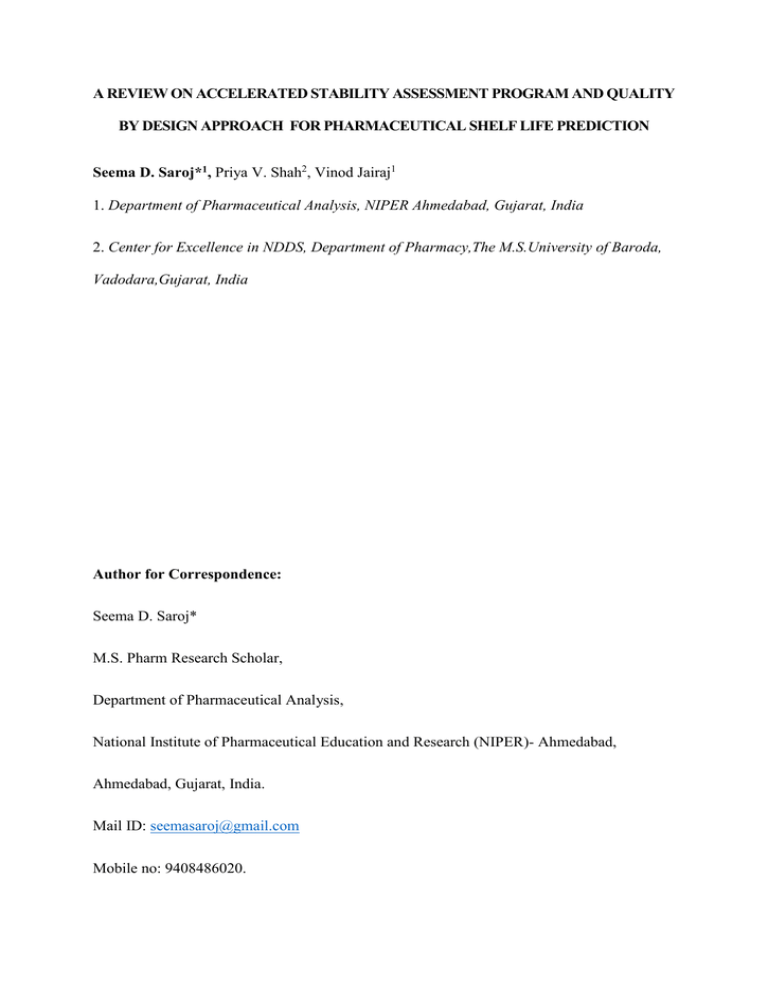quality by design approach - International Journal of Advances in
advertisement

A REVIEW ON ACCELERATED STABILITY ASSESSMENT PROGRAM AND QUALITY BY DESIGN APPROACH FOR PHARMACEUTICAL SHELF LIFE PREDICTION Seema D. Saroj*1, Priya V. Shah2, Vinod Jairaj1 1. Department of Pharmaceutical Analysis, NIPER Ahmedabad, Gujarat, India 2. Center for Excellence in NDDS, Department of Pharmacy,The M.S.University of Baroda, Vadodara,Gujarat, India Author for Correspondence: Seema D. Saroj* M.S. Pharm Research Scholar, Department of Pharmaceutical Analysis, National Institute of Pharmaceutical Education and Research (NIPER)- Ahmedabad, Ahmedabad, Gujarat, India. Mail ID: seemasaroj@gmail.com Mobile no: 9408486020. ABSTRACT: Accelerated Stability Assessment Program (ASAP) is a relatively newer approach for accurately determining the shelf life of drug substance as well as drug product in a short period of time (typically 2-3 weeks). The effect of temperature and humidity are both quantified in this effective approach. Its an isoconversion prototype in which the drug substance or drug product is exposed to a range of high temperatures and humidity within a DoE-like study design followed by testing of samples for assay and degradation products formed. The results are fitted to ASAP equation giving a relationship of degradation level to temperature and humidity variation. After the data is modelled it is possible to predict the stability of drug substance or drug product at any time, temperature or humidity. Thus, it plays a very crucial role in providing the product understanding important for a Quality by Design (QbD) filing for approval of the product and promoting rational control strategies to indemnify product stability. Key Words: ASAP, Expiration dating, QbD, Stability, Kinetics. INTRODUCTION: Chemical Stability of pharmaceutical products and substances is very important and needs to be established since it is directly related to safety and efficacy (1). Expiration dating or shelf life is generally based on the time period a drug product or a drug substance remains within the specification limits pertaining to potency or of individual or all degradation products at the advocated storage conditions. Accelerated Stability Assessment Program (ASAP) is a modelling tool used in the development that improves the understanding of product development . It is quite faster than the conventional stability and package screening studies. This review deals with ASAP description, advantages and its application in the pharmaceutical industry. The ASAP in itself has lots of potential to change the way stability studies are being looked into and performed by various pharmaceutical industries. This approach leads to considerable reduction in the time required in performing stability studies on drug substance and drug product, without causing any risk or harm to patient’s health. K.C. Waterman has been a pioneer in this field and useful literature associated with ASAP is available, authored by him(2),(7). The ASAP includes five components: (1) An isoconversion concept for compensating the complications of solid-state kinetics, (2) A moisture-rectified Arrhenius equation accounting for the effect of relative humidity on rate of reaction (3) Use of statistical design and analysis for providing shelf life estimation as well as calculating the error bar associated with the prediction, (4) Merging the relative humidity (RH) data with the safety provided by the packaging to explicitly determine the shelf life of the product at different RH and stability under various packaging conditions, last but not the least, (5) Proficiency to determine the critical qualility attributes (CQAs) having an impact on the stability of the product (2). Quality by Design (QbD) is a systematic approach to development that begins with predefined objectives and emphasizes product understanding and process control, also it is based on the sound science of quality risk management (QRM) (3). CQAs are physical, chemical or other such characteristics that should be within an appropriate limit, range, or distribution so as to ensure and achieve the desired product quality. CQAs are generally associated with the drug substance, excipient, intermediates (in-process materials) and drug product(3). Design Space (DS) is the multidimensional combination and interaction of input details like material attributes and process parameters that have already been demonstrated to provide quality assurance. This means that all parameters (input variables) which have a strong influence on quality can be studied in combination, thus defining a perfectly known multidimensional space (4) . Movement out of the design space is considered to be a change. Therefore, there is a freedom to change parameters within the DS (5). Thus, ASAP builds the confidence to produce batches rapidly with prediction and expectation that the shelf life will be acceptable within all batches. But, QbD provides us the anticipated change which will occur on varying certain factors or parameters. And combined use of both approaches will reduce the margin of error to minimal or none.Figure 1 is a depiction of both QbD and ASAP synergistically contributing for determination of shelf life. ASAP STEPS (2) Isoconversion Concept The isoconversion approach improves accuracy and minimizes the risks associated in multiple API micro-environments in solid state dosage forms. In the solution state the molecules are quite far apart and hence the rate of reaction for formation of product directly depends on the order of reaction. The order of reaction concentrations in the rate law is defined as sum of power (6) . But, in the solid state the molecules have lowest mobility, and they exist in multiple non-equilibrating states naming a few like crystal lattice, amorphous and solid solution amongst others. The concern here is that each of these states can react among themselves in different ways to form products, each with its own different kinetics. Hence, there is deviation from main target or kinetics in which we are interested. As mentioned earlier it is difficult to interprete complex kinetics as it is difficult to make out the individual contributions. The concept of isoconversion proves quite useful in these scenario (2, 7). Here, only the time required by the reaction to give specification limits for level of degradation reached or formation of degradant is considered. In the traditional approach the time points are fixed and the level of degradation is calculated. However, in ASAP the level of degradation is fixed and time points are varied and by extrapolation the level of degradant formed is predicted at various temperature and time points.With isoconversion concept rate constant at any storage order will have same contributions from different existing states (2) .The samples here are removed at same constant or specified degradation level, at different time intervals and different temperature and relative humidity. Effect of humidity on rate of reaction Humidity does affect the reaction rate in a particular way (8) .Many historical stability studies do not control relative humidity (RH) and hence the obtained data may be unpredictable. Both the API (active pharmaceutical ingredient) as well as the drug product are affected by changes in RH .The conventional Arrhenius equation doesn’t have inclusion of RH in (9) it(10).But the moisture modified Arrhenius equation does include the RH term along with Temperature effects(2).Thus RH and rate of degradation are dependent and hence a moisture corrected Arrhenius equation is required (11).This is represented in equation 1(2) lnk = lnA – Ea/RT + B(RH) ………..1 where,k is the degradation rate A=Arrhenius collision frequency R=Gas constant (1.986 cal/(mol K)) T=Temperature in kelvin Ea= Activation energy B=Humidity sensitivity constant Analysis of data using statistics From the data obtained the three terms as mentioned before in the equation are to determined viz, A, Ea and B (12). But for this minimum three expeiments are required. In all of these the temperature and humidity are to be varied at various levels. Therefore, slowly a more accurate protocol is obtained. Though there may be cetain disadvantages associated with use of statistics like precision of tha assay will lead to erratic shelf life determination, or extrapolation on humidity and temperature axes if done more than actual will lead to erratic shelf life estimation. However, these issues can be addressed and overcomed by more number of experiments so as to achieve accuracy (2). SHELF LIFE : The term “Shelf life” or “Expiration dating” are used synonymously in pharmaceutical field. The different terms related to shelf life type are: True shelf life, Estimated shelf life, Supported shelf life, Maximum shelf life, Labeled shelf life (13). True shelf life also referred to as true product shelf life is true but the limit on storage time period is unknown. Therefore, this unknown storage time period is determined by stability study. During stability study experiment, the product is exposed to or stored in different stability chambers for a specific period of time. Timely, sampling is done and proper estimate of true product shelf life is taken, from the data obtained. This is referred to as Estimated shelf life. A suitable conservative estimate of true shelf life which is backed by statistical calculations is known as Supported shelf life. A conservative estimate as mentioned is necessary so as to ensure that the product is fit for use upto estimated storage time period. The maximum allowable extrapolated expiration dating as per ICH Q1E is termed as Maximum shelf life (13, 14) . Labeled shelf life is defined as the one shorter of Supported shelf life and Maximum shelf life. It is the one stated on the label of the product and used to calculate the expiry date of the product. It should be noted that each batch is distinguished or known by its own shelf life known as True batch shelf life. As per conventional methods various ways for shelf life determination are FDA’s method, Direct method and Indirect method described in detail by Shao and Chow (15). STABILITY STUDIES : Stability studies are the most important foremost requirement for shelf-life determination of pharmaceutical drug substances and drug products. Without stability data no approval is granted. They are very important as apart from shelf life prediction we also come to know if there is any drug-drug or drug-excepients interaction happening, which may lead to changes in product appearance or decrease in its therapeutic efficacy (16) . This is required as compatibility needs to be established between the Acive pharmaceutical ingredients and various excipients to ensure a stable, effective, attractive and safe final product (17). They also provide us with a scientific evidence of deciding whether the packing is proper or not, that is if any change is required in the packaging material used. A good safe packaging material is required to maintain the integrity of product during storage, transportation and delivery (18) Severe coondotions that may be encountered by the drug during storage and distribution are also covered and hence stability is ensured. Additional controls if required for maintanence of stability can be known and employed.International conference on harmonisation guideline ICH Q1A (R2) deals with the stability testing of new drug substances and new drug products (19) . The stability conditions are as given in Table 1. Basically there are three types namely; Long term stability, Intermediate stability and Accelerated stability. QUALITY BY DESIGN APPROACH QbD is based on the Juran’s concept of building the quality of product beforehand, rather than after completion of the process unlike in the Quality by Testing (QbT) approach (20) .Nowadays, QbD has become an essential part of any manufacturing process or method development (21, 22). In this approach first of all the Target Product Profile (TPP) is established followed by detrning CQAs and CMPs affecting them and a design space is created (23) . Design Of Experiments (DoE) is a very important tool of QbD(24). In present situation the application of DoE has been simplified by various softwares available like Design Expert 9 (DX®) by State-Ease, JMP by SAS, Statistica by statsoft, Minitab etc. Choosing and applying a appropriate design is a critical decision to be made when using DoE. Various designs generally used are two level full-factorial design, fractional factorial design (FFD), Doptimal. In RSM that is response surface methodology Box behnken and Central composite design are used. Generally FFD and Placket-Burmann design (PBD) are screening designs. They are used for identifying the effect of mehod parameters on CQAs. Later, the identified parameters are optimized using optimization designs like Box-behnken design (BBD), Central composie design (CCD) etc. BBD with RSM is used to evaluate the main, interaction and quadratic effects of factors on the desired Quality attributes (25) .Watermann k. has suggested the use of designs which involve atleast five experiments as minimum with atleast two degrees of freedom for this purpose (2). APPLICATIONS AND RECENT TRENDS Use of both these methods like QbD and ASAP in pharmaceutical shelf-life prediction gives better and faster results as compared to conventional methods.Precise and accurate shelf life estimations can be made within two weeks product specific protocol can be made which further help in formulation development,package selection, shelf-life determination and also in determining the effect of post approval changes in materials or processs or both (26) . Once the protocol is developed it leads to easy QbD filing. Also rational control strategies to control product stablity can be determined.Another important advantage with ASAP is that it acts as a base for employing different control strategies so as to adapt to different storage requirements of different regions. The recent trends or advances include availability of software for this like ASAP prime by freethink technologies, ATG scientific software by Amebis Ltd and others.These make it relatively simple to implement the combined concept. CONCLUSION The present review covers the importance, method and application of both QbD and ASAP for determination of shelf life of pharmaceutical product.this reduces the time required to perform stability studies by a significant margin and its employment will be of great benefit and profitable. Employment of both this approach together also leads to more accurate and precise stability data for shelf life determination purpose. ACKNOWLEGEMENT We acknowledge the efforts of Kenneth Watermann, who is a pioneer in this field. REFERENCES 1. Blessy M, Patel RD, Prajapati PN, Agrawal Y. Development of forced degradation and stability indicating studies of drugs—A review. Journal of Pharmaceutical Analysis. 2014;4(3):159-65. 2. Waterman KC. The application of the Accelerated Stability Assessment Program (ASAP) to quality by design (QbD) for drug product stability. AAPS PharmSciTech. 2011;12(3):932-7. 3. Guideline IHT. Pharmaceutical Development Q8 (R2). ICH Steering Committee, Step. 2009;4. 4. Monks K, Rieger H-J, Molnár I. Expanding the term “Design Space” in high performance liquid chromatography (I). Journal of pharmaceutical and biomedical analysis. 2011;56(5):874-9. 5. Peraman R, Bhadraya K, Padmanabha Reddy Y. Analytical Quality by Design: A Tool for Regulatory Flexibility and Robust Analytics. International journal of analytical chemistry. 2015;2015. 6. Bahl A, Bahl B, Tuli GD. Essentials of physical chemistry: S. Chand; 2012. 7. Waterman KC, Carella AJ, Gumkowski MJ, Lukulay P, MacDonald BC, Roy MC, et al. Improved protocol and data analysis for accelerated shelf-life estimation of solid dosage forms. Pharmaceutical research. 2007;24(4):780-90. 8. Zhao J, Yang X. Photocatalytic oxidation for indoor air purification: a literature review. Building and Environment. 2003;38(5):645-54. 9. Young PM, Price R, Tobyn MJ, Buttrum M, Dey F. Effect of humidity on aerosolization of micronized drugs. Drug development and industrial pharmacy. 2003;29(9):959-66. 10. Laidler KJ. The development of the Arrhenius equation. Journal of Chemical Education. 1984;61(6):494. 11. Baertschi SW, Jansen PJ. Stress testing: a predictive tool. Drugs and the pharmaceutical sciences. 2005;153:13. 12. Glantz SA. Primer of biostatistics. 2005. 13. Capen R, Christopher D, Forenzo P, Ireland C, Liu O, Lyapustina S, et al. On the shelf life of pharmaceutical products. AAPS PharmSciTech. 2012;13(3):911-8. 14. Guideline IHT, editor Evaluation for Stability Data Q1E. International Conference on Harmonisation of Technical Requirements for Registration of Pharmaceuticals for Human Use; 2003. 15. Shao J, Chow S-C. Drug shelf-life estimation. Statistica Sinica. 2001;11(3):737-46. 16. Singh S, Junwal M, Modhe G, Tiwari H, Kurmi M, Parashar N, et al. Forced degradation studies to assess the stability of drugs and products. TRAC Trends in Analytical Chemistry. 2013;49:71-88. 17. Daharwal S, Jangade RK, Thakur VD, Sahu BP. Compatibility Study of Ambroxol HCl Drug-Excipients by Using IR Spectroscopy. Asian Journal of Pharmaceutical Analysis. 2013;3(3):98-101. 18. Naghavi Alhosseini SS, Danai H, Nassaji Kamrani M. Impact of Innovation Variables on Quality of Pharmaceutical Products Packaging. Journal of Applied Packaging Research. 2015;8(1):1. 19. Guideline IHT. Stability testing of new drug substances and products. Q1A (R2), Current Step. 2003;4. 20. Juran JM. Juran on quality by design: the new steps for planning quality into goods and services: Simon and Schuster; 1992. 21. Deshpande GR, Roy AK, Rao NS, Rao BM, Reddy JR. Rapid screening of volatile ion-pair reagents using UHPLC and robust analytical method development using DoE for an acetyl cholinesterase inhibitor: Galantamine HBr. Chromatographia. 2011;73(7-8):639-48. 22. Mohammed AQ, Sunkari PK, Srinivas P, Roy AK. Quality by Design in Action 1: Controlling Critical Quality Attributes of an Active Pharmaceutical Ingredient. Organic Process Research & Development. 2015. 23. Roy S. Quality by design: A holistic concept of building quality in pharmaceuticals. International Journal of Pharmaceutical and Biomedical Research. 2012;3(2):100-8. 24. Wu H, Tawakkul M, White M, Khan MA. Quality-by-Design (QbD): An integrated multivariate approach for the component quantification in powder blends. International Journal of Pharmaceutics. 2009;372(1):39-48. 25. Awotwe-Otoo D, Agarabi C, Faustino PJ, Habib MJ, Lee S, Khan MA, et al. Application of quality by design elements for the development and optimization of an analytical method for protamine sulfate. Journal of pharmaceutical and biomedical analysis. 2012;62:61-7. 26. Waterman K, Colgan S, Waterman K. A science-based approach to setting expiry dating for solid drug products. Regulatory Rapporteur. 2008;5(7):9-14. ASAP QbD Shelf-life prediction Figure 1. ASAP and QbD synergists for shelf-life determination. Study Storage conditions Minimum covered time by period data at submission Long term* 25ºC ± 2ºC/40% RH ± 12 months 5%RH or 30°C ± 2°C/35% RH ± 5% RH Intermediate** 30ºC ± 2ºC/65% RH ± 6 months 5%RH accelerated 40ºC ± 2ºC/not more than 6 months (NMT) 25% RH * It is up to the applicant to decide whether long term stability studies are performed at 25°C ± 2°C/40% RH ± 5% RH or 30°C ± 2° C/35% RH ± 5% RH. ** If 30°C ± 2°C/35% RH ± 5% RH is the long-term condition, there is no intermediate condition. Table 1. Stability conditions as per ICH Q1A (R2).





